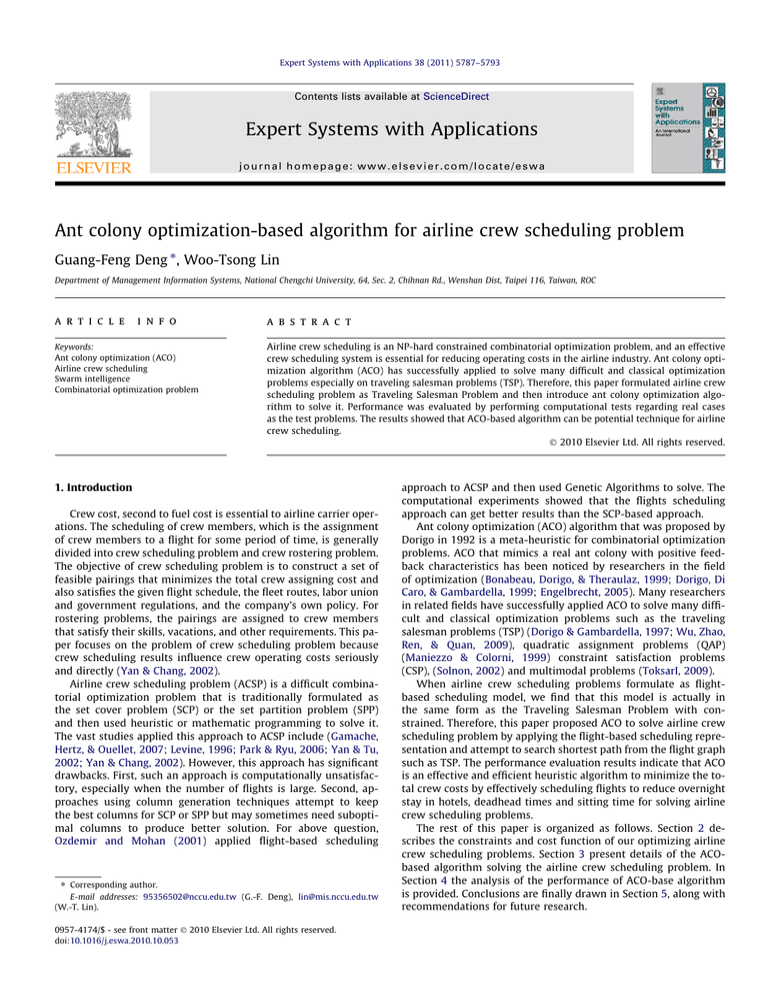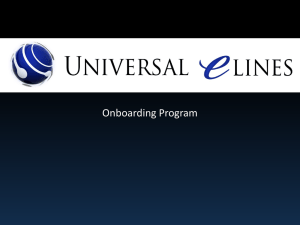
Expert Systems with Applications 38 (2011) 5787–5793
Contents lists available at ScienceDirect
Expert Systems with Applications
journal homepage: www.elsevier.com/locate/eswa
Ant colony optimization-based algorithm for airline crew scheduling problem
Guang-Feng Deng ⇑, Woo-Tsong Lin
Department of Management Information Systems, National Chengchi University, 64, Sec. 2, Chihnan Rd., Wenshan Dist, Taipei 116, Taiwan, ROC
a r t i c l e
i n f o
Keywords:
Ant colony optimization (ACO)
Airline crew scheduling
Swarm intelligence
Combinatorial optimization problem
a b s t r a c t
Airline crew scheduling is an NP-hard constrained combinatorial optimization problem, and an effective
crew scheduling system is essential for reducing operating costs in the airline industry. Ant colony optimization algorithm (ACO) has successfully applied to solve many difficult and classical optimization
problems especially on traveling salesman problems (TSP). Therefore, this paper formulated airline crew
scheduling problem as Traveling Salesman Problem and then introduce ant colony optimization algorithm to solve it. Performance was evaluated by performing computational tests regarding real cases
as the test problems. The results showed that ACO-based algorithm can be potential technique for airline
crew scheduling.
Ó 2010 Elsevier Ltd. All rights reserved.
1. Introduction
Crew cost, second to fuel cost is essential to airline carrier operations. The scheduling of crew members, which is the assignment
of crew members to a flight for some period of time, is generally
divided into crew scheduling problem and crew rostering problem.
The objective of crew scheduling problem is to construct a set of
feasible pairings that minimizes the total crew assigning cost and
also satisfies the given flight schedule, the fleet routes, labor union
and government regulations, and the company’s own policy. For
rostering problems, the pairings are assigned to crew members
that satisfy their skills, vacations, and other requirements. This paper focuses on the problem of crew scheduling problem because
crew scheduling results influence crew operating costs seriously
and directly (Yan & Chang, 2002).
Airline crew scheduling problem (ACSP) is a difficult combinatorial optimization problem that is traditionally formulated as
the set cover problem (SCP) or the set partition problem (SPP)
and then used heuristic or mathematic programming to solve it.
The vast studies applied this approach to ACSP include (Gamache,
Hertz, & Ouellet, 2007; Levine, 1996; Park & Ryu, 2006; Yan & Tu,
2002; Yan & Chang, 2002). However, this approach has significant
drawbacks. First, such an approach is computationally unsatisfactory, especially when the number of flights is large. Second, approaches using column generation techniques attempt to keep
the best columns for SCP or SPP but may sometimes need suboptimal columns to produce better solution. For above question,
Ozdemir and Mohan (2001) applied flight-based scheduling
⇑ Corresponding author.
E-mail addresses: 95356502@nccu.edu.tw (G.-F. Deng), lin@mis.nccu.edu.tw
(W.-T. Lin).
0957-4174/$ - see front matter Ó 2010 Elsevier Ltd. All rights reserved.
doi:10.1016/j.eswa.2010.10.053
approach to ACSP and then used Genetic Algorithms to solve. The
computational experiments showed that the flights scheduling
approach can get better results than the SCP-based approach.
Ant colony optimization (ACO) algorithm that was proposed by
Dorigo in 1992 is a meta-heuristic for combinatorial optimization
problems. ACO that mimics a real ant colony with positive feedback characteristics has been noticed by researchers in the field
of optimization (Bonabeau, Dorigo, & Theraulaz, 1999; Dorigo, Di
Caro, & Gambardella, 1999; Engelbrecht, 2005). Many researchers
in related fields have successfully applied ACO to solve many difficult and classical optimization problems such as the traveling
salesman problems (TSP) (Dorigo & Gambardella, 1997; Wu, Zhao,
Ren, & Quan, 2009), quadratic assignment problems (QAP)
(Maniezzo & Colorni, 1999) constraint satisfaction problems
(CSP), (Solnon, 2002) and multimodal problems (ToksarI, 2009).
When airline crew scheduling problems formulate as flightbased scheduling model, we find that this model is actually in
the same form as the Traveling Salesman Problem with constrained. Therefore, this paper proposed ACO to solve airline crew
scheduling problem by applying the flight-based scheduling representation and attempt to search shortest path from the flight graph
such as TSP. The performance evaluation results indicate that ACO
is an effective and efficient heuristic algorithm to minimize the total crew costs by effectively scheduling flights to reduce overnight
stay in hotels, deadhead times and sitting time for solving airline
crew scheduling problems.
The rest of this paper is organized as follows. Section 2 describes the constraints and cost function of our optimizing airline
crew scheduling problems. Section 3 present details of the ACObased algorithm solving the airline crew scheduling problem. In
Section 4 the analysis of the performance of ACO-base algorithm
is provided. Conclusions are finally drawn in Section 5, along with
recommendations for future research.
5788
G.-F. Deng, W.-T. Lin / Expert Systems with Applications 38 (2011) 5787–5793
2. Airline crew scheduling problem
work
T duty
p
The goal of airline crew scheduling problem is to minimize the
total crew costs by effectively scheduling flights to reduce overnight stay in hotels, deadhead times and sitting time to achieve
feasible minimum cost of pairing sets. The cost function of ACSP
is determined by summing up the payments of three parts, including required pay (minimum payment) for each duty in each pairing
(rotation), rest expenses between pairings, and under-utilized time
between duties in each pairing. For an airline crew scheduling
problem that consists of n flights, m duties and o pairings of duties,
the cost function of the ACSP can be defined as follows:
¼ T check
in
þ T check
out
þ
n X
n
X
i¼1
!
zipl T fly
i
þ xij j¼1
8 l ¼ 1; 2; 3; . . . ; o 8 p ¼ 1; 2; 3; . . . ; m
ð2:3Þ
(5) Flying hour constraint for a duty: a duty can contain one or
more shortly connected flights, but the total flying time in a
duty must be less than the maximum flying time in a duty
ðT max
duty fly Þ. The expression is as follows:
n
X
max
zip T fly
i 6 T duty
fly
ð2:4Þ
i¼1
Min
m
X
"
C duty
basic
þ C fly
extre
per-diem
p¼1
þ
n
X
!
zip T fly
i
#
T min
paid
8 p ¼ 1; 2; 3; . . . ; m
fly
(6) Sitting hour constraints:
This is a setting of the minimum sitting time (or time
delay) between consecutive flights ðT min
sit Þ:
i¼1
m X
m
X
ypq C rest
hotel
rest
þ C rest
per-diem T pq
p¼1 q¼1
req
þC under-utility T rest
pq T pq
rest
ð2:1Þ
The cost function components for the pairing sequence assigned
to a crew includes:
(1) Required pay for each duty in each pairing:
Cduty_basic: the basic minimum payment for a duty,
C fly
extre per-diem : the bonus for overtime flying for each extra
minute, T min
: minimum paid flying time in minutes in a
P paid fly
fly
duty. ni¼1 zip T fly
i : flying time in the duty p. T i is the flying
time of flight i. Zipl is used to check whether flight i is contained in the duty p of the pairing o (set to 1) or otherwise
(set to 0).
(2) Rest expenses between pairings:
The rest expenses include hotel and per-diem expenses
when crew stays away from his/her domicile. T rest
pq is the rest
time between two consecutive duties p and q, and C rest
per-diem
represents the additional pay for each minute of rest time,
ypq is designed to check whether duty q was flown after duty
p, (ypq = 1) or otherwise (ypq = 0). Crest_hotel: the hotel expense.
(3) Under-utilized time between duties in each pairing:
If the length of rest between two duties is longer than the
rest
required rest time ðT req
Þ, then this under-utility crew
pq
time is added. Cunder-utility: the loss to the company when
one minute of a crew time is wasted.
The ACSP decision rules contain constraints on flying hours, and
working and sitting hours for each duty. The decision rules for the
ACSP are listed as follows:
(1) Consecutive city constraint: the next flight must leave from
the destination city of the previous flight.
(2) Flight numbers constraints: these are settings of the maximum flights allowed in a duty ðN max
duty Þ and the maximum
flights allowed in a pairing ðN max
Þ.
pairing
(3) Maximum sitting time for a duty: this is a setting of the
maximum sitting time between flights ðT max
sit Þ. If a minimum
time delay between consecutive flight legs in a duty is larger
than T max
sit , the crew members must be sent to rest in a hotel.
(4) Working hour constraint for a duty: the total working time
in a duty must be less than the maximum working time in
a duty ðT max
duty work Þ:
T duty
p
work
6 T max
duty
T max
duty work :
T sit
ij
ð2:2Þ
work
T pduty work :
where
maximum work time in a duty.
working time in a duty. It is calculated as following:
min
T sit
ij P T sit
8 xij ¼ 1 i ¼ 1; 2; 3; . . . ; n 8 j ¼ 1; 2; 3; . . . ; n
ð2:5Þ
A cabin crew that is assigned to a duty which is longer
than 12 h, must be put to rest for at least 24 consecutive
hours. Decision rule for this restriction can be expressed
as follows:
T req
pq
rest
P 24 if T duty
p
work
P 12 & ypq ¼ 1
ð2:6Þ
req rest
T pq
:
where
the minimum required rest time between
consecutive duty p and duty qA cabin crew that is assigned to work for more than 8 h but less than 12 h should
be put to rest for at least 12 consecutive hours. The
expression is as follows:
T req
pq
rest
P 12 if T duty
p
work
P 8 & ypq ¼ 1
ð2:7Þ
A cabin crew that is assigned to a duty period for less
than 8 hours should be given a scheduled rest period of
at least 8 consecutive hours. The expression is as follows:
T req
pq
rest
P 8 if T duty
p
work
6 8 & ypq ¼ 1
ð2:8Þ
3. Ant colony optimization (ACO) for airline crew scheduling
The idea of ACO was inspired by the foraging behavior of ant
colonies that find the shortest route between ant’s nest and a
source of food by exchanging information via pheromone deposited on the trips. This pheromone information is used to guide
the route search and let ants cooperate with each other as a whole
community to achieve robust behavior capable of finding high
quality solutions in a large search space. When applying ACO algorithm to solve combinatorial optimization problems, the main task
is to model the problem as the search of the shortest path over a
weighted and constraint graph. Then, ants walk though the graph,
keep track of promising search routes by laying trails of pheromone, and look for good paths depending on both pheromone trail
and some problem-specific local heuristic data.
This section explains details of construction of ACO-based algorithm for solving airline crew scheduling problems systematically.
This work formulates the airline crew scheduling problem as a
Traveling Salesman Problem (TSP) model by applying flight-based
scheduling and builds the shortest path from the flight graph by
ACO. After transforming the ACSP into a TSP-type model that uses
a flight graph representation, the scheduling problem can then be
recognized as the search for the path with minimum cost in a
graph that uses flights as nodes of paths, and the connecting edges
to conform to the constraints between two consecutive flights. So

